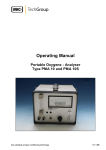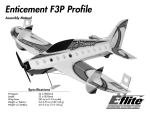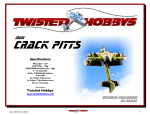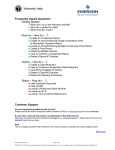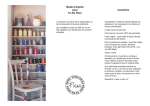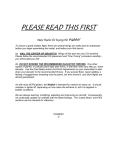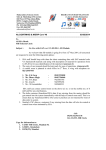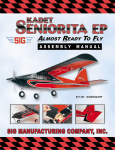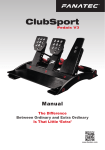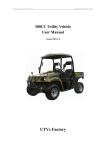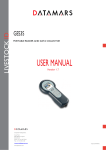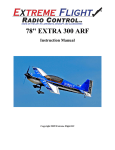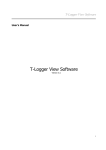Download 32” Crack Yak-55
Transcript
32” Crack Yak-55 By RC Factory Specifications Wing span – 32” / Length – 31” AUW 160-175g (with Landing Gear) 50 - 70w outrunner motor (19g – 24g) 6 - 12 amp ESC / 2s 360 – 450mAh battery 4 ch radio / 2x 4g servos / 1x 9g servo 8x4.3 prop USA Distributor Twisted Hobbys www.twistedhobbys.com Rev: 2012.11.04.v004a 1 TABLE OF CONTENTS Page WARNING INFORMATION...................................................................................................................................................3 SHIPPING DAMAGE...............................................................................................................................................................3 OUR MISSION ..........................................................................................................................................................................3 SAFETY NOTES .......................................................................................................................................................................4 IMPORTANT: PRIOR TO ANY ASSEMBLY ..............................................................................................................4 KIT CONTENTS .......................................................................................................................................................................5 OPTIONAL PARTS ..................................................................................................................................................................6 TOOLS & ADHESIVES NEEDED..........................................................................................................................................7 THE BUILD ...............................................................................................................................................................................8 CENTER OF GRAVITY ........................................................................................................................................................48 CONTROL THROWS ............................................................................................................................................................48 3D Flight ..........................................................................................................................................................................48 Sport .................................................................................................................................................................................48 PRE-FLIGHT & TESTING ...................................................................................................................................................49 PREFLIGHT CHECKS ...............................................................................................................................................................49 Motor................................................................................................................................................................................49 Flight Controls .................................................................................................................................................................49 Batteries ...........................................................................................................................................................................49 Radio ................................................................................................................................................................................49 Range Check.....................................................................................................................................................................49 FLIGHT TESTING ....................................................................................................................................................................49 STORAGE ...............................................................................................................................................................................49 NOTES & S/U SHEET ............................................................................................................................................................50 TIPS AND TRICKS ................................................................................................................................................................51 Rev: 2012.11.04.v004a 2 TWISTED HOBBYS Website: www.twistedhobbys.com – email: [email protected] Thank you for your purchasing a Twisted Hobbys’ model. Please read through the entire manual before beginning to build this model. If you have any questions please contact us at the above indicated email address. WARNING INFORMATION This R/C Aircraft is not a toy! Read and understand the entire manual before assembly. If misused, it can cause serious bodily harm and property damage. Fly only in open areas, and AMA (Academy of Model Aeronautics) approved flying sites. Do not over look the warnings and instructions enclosed or those provided by other manufactures’ products. If you are not an experienced pilot and airplane modeler you must use the help of an experienced pilot or an authorized flight instructor for the building and flying of this model aircraft. These instructions are suggestions only on how to assemble this model. There are other ways and methods to do so. Twisted Hobbys has no control over the final assembly, the materials and accessories used when assembling this kit, or the manner in which the assembled model, installed radio gear and electronic parts are used and maintained. Thus, no liability is assumed or accepted for any damage resulting from the use of the assembled model aircraft or from this instruction manual including but not limited to direct, indirect, incidental, special, and consequential damages. By the act of using this user-assembled product, the user accepts all resulting liability. In no event shall Twisted Hobbys’ liability exceed the original purchase price of the kit. SHIPPING DAMAGE Twisted Hobbys checks each plane before shipping to ensure that each kit is in fine condition. We have no bearing on the condition of any component parts damaged by use, modification, or assembly of the model. Inspect the components of this kit upon receipt. If you find any parts damaged or missing, contact Twisted Hobbys immediately. We will not accept the return or replacement of parts on which assembly work has already begun. Twisted Hobbys reserves the right to change this warranty at anytime without notice. OUR MISSION To provide the best products and service to our customers at the lowest prices possible. We take great pride in our company, our commitment to customer service and in the products we sell. Our online store is designed to provide you with a safe and secure environment to browse our product catalog. Thank you for shopping with Twisted Hobbys! Rev: 2012.11.04.v004a 3 SAFETY NOTES Before assembling and flying this model, read carefully any instructions and warnings of other manufacturers for all the products you installed or used on your model, especially radio equipment and power source. Check thoroughly before ever flight that the airplanes’ components are in good shape and functioning properly. If you find a fault do not fly the model until you have corrected the problem. Radio interference caused by unknown sources can occur at any time without notice. In such a case, your model will be uncontrollable and completely unpredictable. Make sure to perform a range check before every flight. If you detect a control problem or interference during a flight, immediately land the model to prevent a potential accident. Youngsters should only be allowed to assemble and fly these models under the instruction and supervision of an experienced adult. Do not operate this model in a confined area. Do not stand in line with, or in front of a spinning propeller and never touch it with any object. IMPORTANT: PRIOR TO ANY ASSEMBLY Please Note: after removing kit from shipping box, lay each piece flat on a hard surface, this will allow the airframe to straighten out if lightly bent from shipping. Do not worry since EPP is very pliable and can be bent back if out of shape. Rev: 2012.11.04.v004a 4 kit contents RC Factory 32” Crack Yak-55, lite standard parts list: 2x 4x 1x 1x 2x 1x 1x 1x 1x 2x 2x – – – – – – – – – – – wing half side force generator fuselage (3 parts) canopy fuselage truss elevator (1 parts) rudder (1 parts) 3mm dia x 700mm wing spar 3mm dia x 300mm wing spar 1mm dia x 500mm control rod 1mm x 3mm x 200mm LG strut Rev: 2012.11.04.v004a hardware packet: 2x 1x 2x 2x 1x 4x 4x 4x 2x – – – – – – – – – 1.5mm dia x 170mm push rod motor mount, fiberglass 1.5mm dia landing gear axle wheels wood horn/accessory kit heat shrink tubing pieces z-bend wires adjustable connectors streamlined wheel pants 5 OPTIONAL PARTS CA and Kicker Power Combo Kit (Matched by Twisted Hobbys) includes: 1x – 1x – 2x – 1x – 1x – Various thickness CA glues and Activator available from Twisted Hobbys’ 50-70w 19-24g Outrunner Motor ESC 12A Twisted Hobbys’ Series 4.5g digital servos 9.0g Servo prop 8x4.3 Micro Receiver Max Recommended Weight: 2.9g Minimum of 4 channels required Perfect choice for building and repairing your Twisted Hobbys EPP planes! This is the only adhesive you will ever need. Welder virtually bonds anything to anything! Clear, heavy-duty, flexible and water-proof when dry. Use indoors or out. (1) 1 oz tube Rev: 2012.11.04.v004a Carbon Fiber 32” Upgrade Horn Kit for “Lite Series” Models 2x - Aileron Control Surface Arms 2x - Rudder/Elevator Control Surface Arms 1x - Aileron Diff Servo Arm 12x - Rod guides 1x - Landing Gear Frame Brace 2x - Landing Gear Wheel/Pants Guides 2x - Landing Gear Axle Angle Brace 4x - Landing Gear Washers 4x - Wing Spar Braces Note: many of these “optional parts” shown or similar items, may be available from the Twisted Hobbys’ web store. 6 Tools & Adhesives Needed • Tape Measure and Ruler • Lighter • Small drill bits • Welders Glue • Hobby Knife w/new Blade Blade • Needle Nose Pliers • Wire Cutters • Low Temp Hot Glue Gun • Course Sand Paper • Scissors • Small Phillips Screw Driver • CA and Activator • Approx 18” string/thread Rev: 2012.11.04.v004a 7 THE BUILD CONSTRUCTION METHODS: Building surface should be at least 2ft x 4ft and flat. Weights or some small heavy objects will be handy for holding things in place during the time glue is setting. Two types of glue are used for the build, Welders glue is use for most areas and CA for the horns and guides. When using the Welders glue, apply a thin film to each surface, surface, allow to sit for approx five minutes minutes and then assemble. assemble. Note that this method will create a nearly instant bond, so locate carefully when bringing the two pieces together. If alignment is necessary while gluing the two pieces together, do not allow the glue to tack up, simple apply and join immediately, you will have several minutes to locate the two parts before the glue sets up. In most cases the parts being glued can be handled with care in 30 minutes, full cure is approx 24 hours. Carbon parts should be sanded and wiped clean prior to gluing. Take necessary precautions to avoid breathing the carbon dust. Remove wing spar ribs that have the oval holes from the wood kit. These are for the inner spar slot where the spar is two rods thick. The center section, to the right in this photo, is where the oval ribs and double spar go. Rev: 2012.11.04.v004a 8 Remove the little tabs of foam that are in the SFG slots with a sharp knife Glue the wings to the fuselage with Welders. Notice how the tabs on each wing prevent you from putting the wings on upside down. NOTE: USE GLUE SPARINGLY AND WIPE OFF OR REMOVE ANY EXCESS. TOO MUCH GLUE WILL INCREASE THE A.U.W. AND AFFECT THE MODEL’S FLYING CHARACTERISTICS. This is how the spar assembly goes together. Short rod in the center first followed by the longer rod over the top of it. Rev: 2012.11.04.v004a 9 Welders will work it’s way through the top of the wing. Use some clear packing tape on the bench to keep it from sticking. Wax paper or Parchment paper could also be used. Install the rods thru the wood ribs as shown. Note that the shorter one is on the bottom. Wing tip rib shown. The hump on both should be facing upward. Rev: 2012.11.04.v004a 10 Lay down a bead of Welders into the rib and spar areas. Lower the assembly into the provided slots allowing any extra glue to squish out. The short spar should be buried in the middle section and the long spar should be flush with the bottom of the wing. The humps in the ribs will stick out on both inner and out ribs as shown. Fill any voids with glue and wipe up as much excess glue as possible. Remember we want to keep things a light as possible. Rev: 2012.11.04.v004a 11 Weigh it down flat on a flat surface and let it dry completely. Pay special attention to ensure that the wing is flat and the spar is straight and true. Get ready to install the elevator. Put Welders on the end of the Fuse and let it tack up. Put Welders on the elevator, spread thin, and let it tack up. Rev: 2012.11.04.v004a 12 After tacking for a few minutes assemble the elevator to the fuselage piece. Notice there is a tab on the stab and fuse that will keep you from putting them on backwards. Assembled elevator to fuselage. Now install the lower part of the fuselage. Put Welders on the tabs and flat spots of the lower fuselage Rev: 2012.11.04.v004a 13 Put Welders in the tab slots and flat spots between the tab slots on the horizontal fuse piece. Be cautious not to put Welders in the servo hole areas. Put the lower fuse onto the horizontal fuse piece while the glue is wet. Make sure it is 90 degrees to the horizontal piece and clean up all the excess glue. While the lower fuse is drying we will install the aileron control horns. There are two different shape control horns in the kit. The ones angled the same as the hinge line of the ailerons are the correct ones. Aileron Control Horn Rev: 2012.11.04.v004a 14 Put Welders on the control horn. Install the control horns while the glue is wet and let dry. You may have to cut out the EPP fuzz in the slot in the wing to get the horn to sit flush. Trial fit before gluing. Also while the lower fuse and control horns are drying, fold over the ailerons and weight them down for a few minutes to loosen up the hinges. Rev: 2012.11.04.v004a 15 Install the upper part of the fuse. Put Welders on the tab slots and flat part of the fuse. Put Welders on the flat parts and tabs of the upper fuse piece, insert wet and let dry. Take care to make sure the upper fuse is in line with the lower fuse and 90 degrees to the horizontal fuse piece. Also make sure the front of all the fuselage pieces are flush. This will be important when mouting the motor. Rev: 2012.11.04.v004a 16 Clean up any excess glue. While the upper fuse is drying put Welders on the canopy area and let it tack up. Put Welders on the canopy itself and let it tack up. Rev: 2012.11.04.v004a 17 After the glue has tacked up, attach the canopy to the fuse. Make sure it is going in the right direction! Put Welders on the Fuse find side and let it tack up. Put Welders on the fuse fin side and let tack up. Put Welders on th fin and let it tack up. No need for glue in the elevator joiner area where the half circle is cut out. Rev: 2012.11.04.v004a 18 While the glue tacks up install the control horn in the rudder the same way we did with the ailerons. Rudder Horn After the Welders has tacked up glue the rudder to the fuse. Start at the top so you can manage the fin to rudder gap and work your way down. While everything is drying, take the time to keep tweaking it so that everything dries perfectly straight. Rev: 2012.11.04.v004a 19 Now you can install the elevator control horn. Elevator Horn Now install the side trusses. Cut one of the tips off the trusses so that you can run the servo wires from the tail servos out of the and tuck the wires back into that space after it is all finished to clean up the radio install. Rev: 2012.11.04.v004a 20 Again, as the glue dries on the trusses keep tweaking and checking to make sure everything is totally straight. These are all the parts to build the LG assembly. 1X 2X 2X 2X - Wood Landing Gear Parts - Carbon Rounds for Axles - Carbon Rectangles for Struts – EPP Wheel Pants Note – your kit may have 4 round parts and no oval parts. First thing you will want to do is drill out the wheels with a 1/16” dia bit, so that the carbon axles fit without binding. Rev: 2012.11.04.v004a 21 Second, you will glue the little ply angle piece (Axle Support) to the end of one of the gear legs with thin CA. Axle Support The angle and flat spot created by the ply piece and the carbon gear leg makes a nice joint to glue in the carbon axle with thin CA. You will put the little circular ply piece over the carbon axle and CA it to the ply angled piece to create a hub for the wheel to run against. If your kit has 4 of these parts, use two per side; one to hold the inside of the wheel and one to hold the outside. Axle Washer Rev: 2012.11.04.v004a 22 Make sure all the pieces are thin CA’d securely. Then wrap the whole joint with thread. After it is wrapped with the thread, hit it with thin CA and kicker to finish of the gear leg. Rev: 2012.11.04.v004a 23 This piece is very strong and light! Next, you will put on the ply wheel pant mount/wheel keeper. It just slides over the axle and glues in place with medium or if you are careful thin CA. If your kit had 4 of the round washers, make sure to put the second one on before gluing on the Pant Support. Wheel Pant Support After your gear legs are made the rectangle ply piece goes into the fuselage here. Note – on some kits the position of the landing gear may be located closer to the nose. Landing Gear Bulkhead Rev: 2012.11.04.v004a 24 Fill the slot with welders. Note – some kits have slots located closer to the nose as shown below. There are also two slots in the horz. fuse piece for the gear legs. Fill them with Welders too. NOTE – If your kit has the forward located landing gear, you can follow the steps as indicated, BUT YOU MUST CHECK FOR CLEARANCE BETWEEN BETWEEN THE LANDING GEAR AND THE AILERON DIFF. HORN. ADJUST THE LOCATION OF THE STRUTS WHERE THEY ATTACH TO THE HORIZONTAL PART OF THE FUSELAGE IF NECESSARY TO AVOID INTERFERENCE. While the glue is still wet, slide the gear legs through the center fuse piece with one in front of the ply block and the other behind. Rev: 2012.11.04.v004a 25 Once the gear leg comes through the fuse, install the oval ply piece over the end of the leg and insert the leg into the slot in the horz. fuse piece. Some kits may not have this part, if this is the case with yours, simply glue right into the foam. Landing Gear End Support Slide the oval ring down onto the EPP and make sure it sits flush on the fuse. Omit this step if your kit did not come with these oval parts. Complete the same thing on the other side. Rev: 2012.11.04.v004a 26 Make sure you have enough Welders in slots and covering the ply pieces. Omit this step if your kit did not come with these oval parts. On the center crossing of the gear legs you will want to take some thread and wrap it around the entire X assembly and ply plate. With Welders this is not hugely important but with CA that area will delaminate without the thread. Clean up the excess glue. Rev: 2012.11.04.v004a 27 Let the glue dry on the gear assembly without weight on the gear. Make sure everything is in place and stays straight as it dries. Put Welders on the wheel pant mounts and let it tack up. Put Welders on the wheel pants and let them tack up. Rev: 2012.11.04.v004a 28 While the glue tacks up on the wheel pants, lets build the pushrods. Scuff up one end of each carbon rod, and the long part of the z-bend. Wipe clean. Install the shrink tube and z-bend as shown. (Scuffed end) Then, let a drop of CA run down the rod and underneath the shrink tubing. Rev: 2012.11.04.v004a 29 Heat the heat shrink to squeeze out excess CA. Hit it with kicker and set aside. Here are four completed pushrods ready to install. Rev: 2012.11.04.v004a 30 Take all the pushrod guides out of the ply sheet and put six on each of the longer two pushrods. Push Rod Guide Install the long pushrods in the tail starting by inserting the Z bend in the tail control horns. Then, using med CA find the first small lasered hole for the pushrod guides and fill it with glue. Rev: 2012.11.04.v004a 31 Install the first guide, push it into place not all the way down to the foam and kick it while holding it in place. Continue with pushrod guide. each subsequent Be very careful not to get any drops of CA onto the pushrods. Rev: 2012.11.04.v004a 32 Now assemble the elevator push rod guide assembly just as you did with the rudder. Time to install the Servos Take the longest servo arm in the hardware package for the servo and scuff up the top side of it. Note – the stock arms will give 4040-45 degrees of throw. Extension is only needed if more throw is desired! Rev: 2012.11.04.v004a 33 Put a dab of thin CA on the servo arm. Now find and remove the two small ply oval shaped ply servo arm extenders that come in the hardware kit. Note you must attach to the top side of the servo arm, also make sure you do not add too much glue since the Adjustable End Link will need to spin freely Servo Arm Extension Kick it and let it dry completely. Rev: 2012.11.04.v004a 34 After it is dry, wrap it with thread, and CA, hit with kicker Completed Assembly. To install the Adjustable links, insert the block thru the horn hole and than with the concaved side facing in, press the keeper washer onto the shaft. Remember that the Link must spin freely, so do not press the keeper on too tigh. This procedure applies to Aileron horns (shown to the left) and Elevator and Rudder servo horns (shown above). Rev: 2012.11.04.v004a 35 Install the servos. I like to install the servos after the airframe is built. Of course you could install them as you build the plane. With the thin EPP it is very easy to install them after constructed and then you can use a very little dab of welders Fish the wires through the fuse and out of the front of the cut off truss. Go in at a 45 degree angle until the servo is seated in the back and then just press downward to pop the servo in place. Rev: 2012.11.04.v004a 36 To insert the rod into the keeper, deflect the elevator all the way down and cut off the rod right at the servo keeper. Check to make sure that the Keeper rotates freely, if not, binding will occur in the control system Install the rod into the keeper and center the surface. Cut off the excess. With the new servos and control geometry we can get really sick throws now! Rev: 2012.11.04.v004a 37 Installed keeper and control rod. Typical for both elevator and rudder DO NOT OVER TIGHTEN THE SCREW, IT WILL DAMAGE THE CONTROL ROD. Next we install the motor mount. Put Welders on the fuse and let it tack up. Rev: 2012.11.04.v004a 38 While the motor mount is tacking we will make the aileron servo arm. You will want to predrill some holes. I use the excess screws that come in the servo hardware package. Use a corresponding drill for the pilot holes. Use two screws to hold the plywood aileron horn to the plastic servo arm. Rev: 2012.11.04.v004a 39 Cut off the ends of the screws. Before installing the aileron servo in the airframe make sure the differential servo arm assembly is removed from the servo, it will be installed once the servo is in place. REMOVE THE SERVO ARM, and as as with the tail servos, work the wires through the fuselage to the Rx area. Then come in with the servo at a 45 degree angle into the cut out, next seat the bottom of the servo and then pop it into place making sure the servo tabs go under the tabs in the fuselage that are there to hold the servo. Use a couple small dabs of welders to secure the servo. Make sure those dabs are in places you can get to them with a knife so that you will be able to remove the servo in the future if the need arises. Center the servo electronically, slide the arm in and mate with the output shaft. Rev: 2012.11.04.v004a 40 Now re-install the servo differential arm assembly back onto the servo as shown, you will neeed to bend the foam a little to allow access to the servo screw. Install the Adjustable Links in the aileron control horns. Put the Z bend side of the pushrod into the aileron servo arm and deflect the aileron to insert the rod into the keeper on the control horns. Rev: 2012.11.04.v004a 41 Manually center the aileron and screw down the setscrew in the keeper. Use a little drop of CA in the keeper to keep the bolt tight. After the flue has fully tacked, install the mount on the fuselage. Take care to make sure it is centered and that each of the tabs lines up with the corresponding fuselage piece. Rev: 2012.11.04.v004a 42 We get tons of throw on the ailerons now! This is great for slow high alpha rollers. NOTE – If setting up for extreme throws make sure the control surfaces move freely to the max positions. Failure to do this will cause an excess amount of current draw and possible damage to the ESC and/or Servos. Install the motor to the mount using four screws. Make sure the motor wires come out on the same side as your electronics. The CG on this plane is still 81.5mm from the LE at the horz fuse piece. Balance appropriately with the battery and cut a slot on the top of the fuse to hold the battery in place. Rev: 2012.11.04.v004a 43 Trace around the battery with a pen and use a sharp knife to cut a hole slightly smaller than the battery. Battery installed. Cut the SFGs out and separate the trailing edges to go over the wing. Rev: 2012.11.04.v004a 44 Put welders in the slots in the wing for the SFGs. Put welders on the tabs and where they intersect the leading edge of the wing. Install the SFGs while the glue is still wet. Rev: 2012.11.04.v004a 45 Wipe off the excess glue. Here is the final electronics install with everything tucked in along the left side. RTF Weight 6.0 ounces. Rev: 2012.11.04.v004a 46 READY TO GO!! ENJOY! Rev: 2012.11.04.v004a 47 Center of Gravity 200mm 200mm back from Nose of the Fuselage Locate the battery last, and use it to establish the proper Center of Gravity. Starting CG point is 81.5mm 81.5mm back from the leading edge of the wing. wing. If wanting to experiment with the CG point, locate the battery with Velcro, Velcro so that it can be moved around during the process of determining the desired spot. Control Throws 3D Flight: 35 to 45 degrees all surfaces (elevator 60 degrees) 60 to 75% expo Sport: 20 to 30 degrees all surfaces 30 to 45% expo For 3D flight, set all the control throw up at 35 to 45 degrees. This airframe is very equally balanced and designed to like similar throw movements. Experiment with Expo and Dual Rates to suit your own flying style. Rev: 2012.11.04.v004a 48 PREPRE-FLIGHT & testing Preflight Checks Flight Testing Motor: Should run smoothly at all stick The first flights should be done with the CG at the recommended position, and reduced control rates until comfortable with your handling of the aircraft. As your experience with the aircraft grows experiment with different CG points and control rates. After all flights, check the aircraft over for damage and/or other items that may adversely effect flight performance. positions, and transition smoothly from low to high RPM. If the motor is turning backwards, reverse two of the three wires between the motor and ESC. Check that the screws holding the motor to the airframe are tight and secure. Flight Controls: Should be centered with sticks in the neutral positions. Ensure that all controls and linkages move freely. Double check that all hinged areas are free from rips or tears. Verify proper control surface directions. Right Roll is – right aileron up, left aileron down, Left Roll is left aileron up and right aileron down. Batteries: Should be fully charged prior to each flight. Watch transmitter battery level and follow manufactures recommendations. Motor battery should not be drained any further than recommended by the manufacture, use a timer to prevent an over discharged condition. Radio: All trims should be set to neutral This airframe is full 3D capable EPP plane and will take anything you throw at it, including the occasional crash. If, as the result of a crash, the foam tears, simple glue with Welders or CA. Many pilots prefer Welders because it remains flexible after drying. CA however, is more suited for the “quick” repair. This aircraft should be flown outdoors. It is the perfect size for the neighbor park or smaller flying fieild, allowing for plenty of opportunity to fly and learn new maneuvers. It is a great stand alone plane, or training aid to perfect routines to be done with larger aircraft. and throttle in the low position. Check that rate switches and mixes are set properly. Range Check: With and without the motor running per radio manufactures instructions. If there is insufficient range or significant reduction with the motor running, resolve and re-test before flying. Storage This EPP plane should be hung from it’s prop when not in use, doing otherwise could cause the airframe to twist. Storage in a hot car could also cause damage. Be safe and enjoy, thank you again for purchasing a Twisted Hobbys’ Product! Rev: 2012.11.04.v004a 49 NOTES & s/u Sheet Rev: 2012.11.04.v004a 50 TIPS AND TRICKS - A good building surface is “drop ceiling” panel from a local hardware store on a nice flat board - use parchment pape between the areas being glued and your work surface - heavy flat objects (like books, batteries, etc.) could be used to hold everything flat - When resetting your radio, start with all the ATV’s or throw volumes at 100%. - Make sure you have set the direction of the servos correctly before attempting to trim for zero position. - If possible try the servo horns in different locations to determine which position will require the least amount of sub trim. - Installing the servo horns in their final location and attaching quick links to the servos may make servo installation much easier later. - On the Orange Rx, the negative pin is the one closest to the flat side of the circuit board. - Keep a good supply of sharp knife blades handy when building a foamie airplane. - Use low temp hot glue for gluing electronics, this will allow for easy removal later if necessary. The low temp hot glue can be “released” by “painting” the glue bead with an alcohol soaked cotton swab a couple times. - A business card with the corners clipped off can be used as a small square. - Allowing the Welders glue to set for five minutes before assembly will shorten the tack up time, just be sure if doing it this way that you get the parts into position quickly, as the glue will start to bond on contact. Any joints that you feel are going to require adjustment, it is best to assembly the pieces while the glue is wet. - The Green (high tack) masking tape works the best when used to clamp things together on an EPP foam airplane. - When gluing the rudder to the fuselage, stick pins could be used to hold in position if wanting to handle the airframe before it is completely dry - A rotary tool with a cutting wheel could be used to produce grooves in fiber glass parts instead of coarse sand paper. Use a hatch pattern. This creates more bonding area for the glue. Rev: 2012.11.04.v004a 51



















































